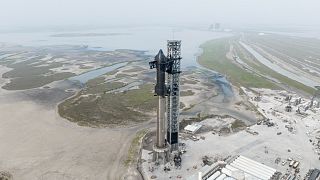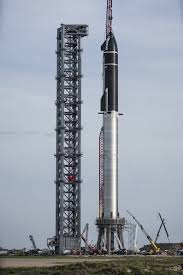Elon Musk’s SpaceX calls off the attempted launch of Starship, the world’s most powerful rocket

This undated photo provided by SpaceX shows the company’s Starship rocket at the launch site in Boca Chica, Texas, USA. – Copyright SpaceX via AP
SpaceX has called off the first launch attempt of its giant new rocket, citing a pressurisation issue.
Starship, the world’s biggest and mightiest rocket ever built, was set to lift off on Monday from Texas in the US for the first time in a much-anticipated test flight.
No people or satellites were aboard. There won’t be another try until at least Wednesday.
Starship was set to blast off on Monday at 1:20 pm GMT (3:20 pm CET) but the launch was cancelled following a technical problem encountered during the very last minutes of the countdown.
However, SpaceX teams continued to run the countdown and simulate take-off operations in the form of a dress rehearsal designed to be stopped just before the scheduled launch time.
about:blank
Elon Musk and his company SpaceX hope the giant rocket will eventually shuttle people to the Moon and Mars.
“Learned a lot today,” Musk tweeted after the launch was called off: “Retrying in a few days”.

Weather conditions were ideal on Monday, and filling the rocket with its cryogenic fuel, liquid oxygen, and methane was going as planned.
But “a pressurant valve seems to be frozen,” Elon Musk tweeted before the postponement was announced, less than 10 minutes before liftoff.
The black and silver giant rocket has never before flown in its full configuration, with its super-powered first stage, called Super Heavy.
Early versions of the sci-fi-looking upper stage rocketed several kilometres into the stratosphere, crashing four times before finally landing upright in 2021.
How big is Starship?
Almost 120 metres tall, the stainless steel Starship has 33 main engines and 7.57 million kg of thrust.
All but two of the methane-fuelled, first-stage engines ignited during a launch pad test in January – good enough to reach orbit, Musk said.
Given its muscle, Starship could lift as much as 227 tonnes and accommodate 100 people on a trip to Mars.
Starship easily eclipses NASA’s Moon rockets – the Saturn V from the bygone Apollo era and the Space Launch System (SLS) from the Artemis program that logged its first lunar trip late last year.
It also outflanks the former Soviet Union’s N1 Moon rocket, which never made it past a minute into flight, exploding with no one aboard.
Musk anticipates using Starship to launch satellites into low-Earth orbit, including his own Starlinks for internet service, before strapping anyone in.
The test flight was set to last 1.5 hours, and fall short of a full orbit of Earth.
Musk said a key goal of the flight was to get the rocket a good distance from the launch site without a hitch.
“Just don’t blow up the launchpad,” he told Twitter users on Sunday.

Shooting for the Moon
With Starship, the California-based SpaceX is focusing on the Moon for now, with a $3 billion (€2.7 billion) NASA contract to land astronauts on the lunar surface as early as 2025, using the upper-stage spacecraft.
It will be the first Moon landing by astronauts in more than 50 years. The moonwalkers will leave Earth via NASA’s Orion capsule and Space Launch System rocket, and then transfer to Starship in lunar orbit for the descent to the surface, and then back to Orion.
To reach the Moon and beyond, Starship will first need to refuel in low-Earth orbit. SpaceX envisions an orbiting depot with window-less Starships as tankers.
But Starship isn’t just for NASA. A private crew will be the first to fly Starship, orbiting Earth. Two private flights to the moon would follow – no landings, just flyarounds.

